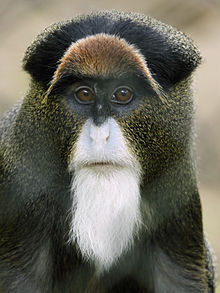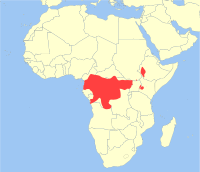- De Brazza's monkey
-
De Brazza's monkey[1] 
Conservation status Scientific classification Kingdom: Animalia Phylum: Chordata Class: Mammalia Order: Primates Family: Cercopithecidae Genus: Cercopithecus Species: C. neglectus Binomial name Cercopithecus neglectus
Schlegel, 1876
Geographic range De Brazza's monkey (Cercopithecus neglectus) is an Old World monkey endemic to the wetlands of central Africa.
Contents
Taxonomy
Locally known as swamp monkeys, these primates are named after the Italian-French explorer Pierre Savorgnan de Brazza. They were given the species name neglectus because of their skill in hiding from predators.[citation needed]
Description
This guenon has grey agouti fur with a reddish brown back, black limbs and tail and a white rump. A white stripe runs down its thigh, and an orange crescent-shaped marking appears on its forehead. Its white eyelids match its muzzle and beard. Both sexes have cheek pouches in which to carry food while they forage, and males have a blue scrotum.
De Brazza's monkey is a sexually dimorphic species; males weigh around 7 kilograms, while females weigh around 4.5 kilograms.[citation needed] Babies weigh about 260 grams.[citation needed]Range
De Brazza's monkey ranges across the swamps, bamboo and dry mountain forests of Angola, Cameroon, Central African Republic, Congo, The Democratic Republic of the Congo, Equatorial Guinea, Ethiopia, Gabon, the Cherangani Hills of Kenya,[3] Sudan, and Uganda. They are mainly arboreal [4].
Behavior
De Brazza's monkey lives for about 22 years.[citation needed] It is a shy, territorial monkey that lives in small social groups.[citation needed] At the head of each social group is the strongest male, whose job is to protect his fellow group members.[citation needed]
De Brazza's monkey communicates with booming sounds, shaking tree branches, and a variety of facial expressions and movements (e.g. shaking its head when stressed out, or nodding with approval).[citation needed]
Predators of the De Brazza's monkey include the leopard, humans, and other primates.[citation needed] However, because of its very good means of protection, De Brazza's monkey is rarely captured.[citation needed] Among these means of protection are the ability to freeze when alarmed, and the ability to camouflage very well with its surroundings.
References
- ^ Groves, C. (2005). Wilson, D. E., & Reeder, D. M, eds. ed. Mammal Species of the World (3rd ed.). Baltimore: Johns Hopkins University Press. pp. 157. OCLC 62265494. ISBN 0-801-88221-4. http://www.bucknell.edu/msw3/browse.asp?id=12100483.
- ^ Struhsaker, S., Oates, J. F., Hart, J. & Butynski, T. M. (2008). Cercopithecus neglectus. In: IUCN 2008. IUCN Red List of Threatened Species. Downloaded on 4 January 2009.
- ^ Karere G. Mugambi, Thomas M. Butynski, Mbaruk A. Suleman & Wilbur Ottichilo. "The Vanishing De Brazza's Monkey (Cercopithecus neglectus Schlegel) in Kenya". International Journal of Primatology. http://www.springerlink.com/content/p18ku34578782545/. Retrieved 2008-03-18.
- ^ "IUCN Redlist: Cercopithecus neglectus". http://www.iucnredlist.org/apps/redlist/details/4223/0.
- Maria Petringa, Brazza, A Life for Africa (2006) ISBN 9781-4259-11980
External links
This Old World monkey-related article is a stub. You can help Wikipedia by expanding it.

